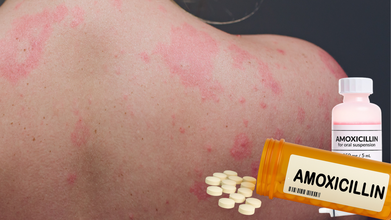- Health Conditions A-Z
- Health & Wellness
- Nutrition
- Fitness
- Health News
- Ayurveda
- Videos
- Medicine A-Z
- Parenting
Is It Safe To Get A Mammogram During Pregnancy?

Image Credit: Health and me
Pregnancy is accompanied by a lengthy list of do's and don'ts—take prenatal vitamins, no alcohol, exercise carefully, and eat well. But what about when an unplanned health issue presents itself, such as the necessity for a mammogram? For most women, this might not even be something they think about until they are in a position where breast cancer screening is an option.
Perhaps you're over 40 and in need of your yearly mammogram, or perhaps you have a history of breast cancer in your family and you want to keep your screenings current. More emergently, you've found a lump in your breast. So, can you have a mammogram when pregnant? The answer is yes, but there are several things to consider.
Pregnancy creates substantial hormonal changes that affect the body, as well as breast tissue. Estrogen and progesterone's rise causes the breasts to expand and condition to produce milk, which results in denser tissue. This increased density is more challenging to detect any abnormalities with using mammograms. Even post-delivery, should the woman be breastfeeding, milk-filled glands can also make the breasts denser and, as a result, make mammogram readings less clear.
While 3D mammograms have improved imaging technology to help navigate dense breast tissue, doctors often suggest postponing routine screening mammograms until after pregnancy if there are no symptoms or high-risk factors. However, if a lump or abnormality is found, your doctor may recommend immediate diagnostic imaging.
When Is a Mammogram Necessary During Pregnancy?
Mammograms are not done routinely if a woman becomes pregnant, yet there are specific situations where one might be unavoidable. Breast cancer in pregnancy does occur—1 in 3,000 times—but it's not common. If a lump is detected by a woman, she has constant breast pain and no explanation, or she is at high risk (e.g., strong history of breast cancer in her family or genetic defect such as BRCA1 or BRCA2), a physician will order a mammogram.
The process itself takes very little radiation exposure. The radiation employed by a mammogram is concentrated on the breast, and there is little to no radiation that reaches other areas of the body. A lead apron is also placed over the belly to shield the unborn child.
Alternative Breast Imaging Options During Pregnancy
For pregnant women requiring breast imaging, physicians may initially suggest an ultrasound. In contrast to a mammogram, an ultrasound is not done with the use of radiation and is deemed safe for pregnant women.
An ultrasound of the breast can establish whether a lump is a fluid-filled cyst or a solid tumor that needs further investigation. Yet ultrasounds are not always diagnostic, and in certain instances, a mammogram or biopsy is needed to determine or rule out cancer.
Magnetic Resonance Imaging (MRI) is also an imaging choice but has some drawbacks. The majority of breast MRIs employ a contrast material called gadolinium, which is able to pass through the placenta and to the fetus. Although risks are not entirely clear, physicians usually do not use MRI with contrast unless necessary. Some practitioners may offer an MRI without contrast as an option.
What If You Find a Lump In Your Breast During Pregnancy?
Breast changes throughout pregnancy are normal, but finding a lump should never be taken lightly. If you notice a lump, alert your medical provider right away. They will conduct a clinical breast exam and potentially have you get an imaging study such as an ultrasound or mammogram to see whether anything needs to be done.
If imaging indicates a suspicious mass, a biopsy can be suggested. Core needle biopsy is the most frequently used and is safe during pregnancy. It consists of numbing the skin with local anesthetic and inserting a hollow needle into the area to obtain a small sample of tissue to be tested.
Breast Cancer Treatment During Pregnancy
In the extremely uncommon event of a diagnosis of breast cancer while pregnant, therapy will be determined by the nature and extent of cancer and by how far along in pregnancy one is. The most frequent form of treatment is surgery—either mastectomy (surgical removal of the entire breast) or lumpectomy (surgical removal of the lump)—which is usually safe while pregnant.
Chemotherapy is also possible but usually only attempted after the first trimester, when it can damage developing fetal tissue. Radiation therapy is not used during pregnancy and is typically deferred until after giving birth. Hormonal therapy and targeted therapies are also omitted until after giving birth.
Can I Get a Mammogram While Breastfeeding?
Yes, you can have a mammogram while you are breastfeeding. The radiation in a mammogram does not impact breast milk or hurt the baby. But breast density is still high during lactation, and this might complicate detection of abnormalities. To enhance image quality, physicians usually advise breastfeeding or pumping 30 minutes prior to the mammogram.
Routine screening mammograms are usually delayed in pregnancy unless there is a high-level concern.
If a lump is detected, an ultrasound is typically the initial imaging study done, with a mammogram being a consideration if additional assessment is necessary.
- Pregnancy mammograms utilize minimal radiation and are safe when required.
- Breast MRI with contrast is usually avoided in pregnancy.
- Breast biopsy, when necessary, is safe during pregnancy.
If breast cancer does develop during pregnancy, there are available treatment options that can be adjusted to keep the mother and infant safe.
Pregnancy is a period of significant change, and health issues particularly those involving breast health, are anxiety-provoking. Routine mammograms are typically postponed until after giving birth, but diagnostic testing can be done if necessary. The best you can do is discuss changes you notice in your breasts with your healthcare provider in an open manner. Early detection and prompt treatment can make a very big difference in the health of both mother and fetus.
What To Do When Amoxicillin Gives You Rashes?

Credits: iStock
This year had been a year of flu, fiver, bacterial illness and more. One of the over the counter medicine that many people often buy, or is prescribed, especially for bacterial infections is Amoxicillin.
What Is Amoxicillin?
It is a widely prescribed antibiotic that is used to treat bacterial infections in children and adults. It is part of the penicillin class of medications and it inhibits the growth of bacteria and allows the immune system to efficiently eliminate the infection. It is commonly used to treat bacterial infections affecting the respiratory tract, urinary tract, and skin.
However, about 5 to 10 per cent of children prescribed this may develop skin rashes as a common side effect. A rash can develop in two forms: allergic and non-allergic. A rash from the drug Amoxicillin could last up to a week.
What Kind Of Rashes Are Caused By Amoxicillin?
A Maculopapular rash is a flat rash that occurs like red patches, raised bumps and spreads over the body.
Hives are itchy, raised red or skin-colored welts that can change shape and location.
Erythema Multiforme are more severe, featuring target-like lesions or bull's-eye shapes with central red spot, pale ring, and red outer ring.
Anaphylactic Reaction is a rare but severe allergic reaction that includes symptoms like difficulty in breathing, swelling of the face, lips, or tongue, hives and rapid drop in blood pressure.
Non-Allergic Amoxicillin Rash are flat, red spots that may be slightly raised, but not harmful. These usually appear o the 5th to 7th day after the start of amoxicillin and can appear on the chest, abdomen, back, face, arms, and legs. It may get worse before it starts to get better.
What Signs Should You Look Out For?
Warning signs include rashes within two hours of the first amoxicillin dose, difficulty breathing or swallowing, or very itchy hives.
The allergic reaction is caused by one's immune system reacting to that medication as if it were a foreign invader in the body.
More girls than boys develop these rashes, and in children this is even more common. In fact, the rash by amoxicillin was first noted in 1960s, in children who were being treated with ampicillin, recorded the Journal of Pediatrics.
What Can You Do If You Get Amoxicillin Rashes?
Among treatment, the first step should be to see your physician and immediately stop taking the medication. Drinking water and enough fluids can also help. Your doctor too would prescribe you medications and lotions to soothe your itching.
Hives can also be treated with the over the counter drug Benadryl. However, you must go see your doctor or GP, and not self medicate.
A doctor may treat the rash in various ways, including stopping the medication as the first line of defense. Then the doctor may give oral antihistamines (e.g., cetirizine) for the itch. Some doctors may use topical steroids to help with the itch and redness.
Before visiting your doctor, take photos of your rash, send it to your GP, as if it is contagious. Even after you start the treatment, stay in touch with your healthcare provider for any development.
36% Of Rabies Death Comes From India: This Is What You Should Do After A Dog Bite, Explains Doctor

Credits: iStock
The World Health Organization (WHO), notes that 36% of world's rabies deaths come from India, and a 2024 Lancet study notes that the country accounts for over one-third of global rabies deaths. When we spoke to Dr Aniket Mule, Consultant Internal Medicine at KIMS Hospital, Thane, he said that it is not just dog bites that lead to rabies, but it could happen from any rabies-susceptible animal. The first line of defense after you clear your wound immediately is to get the rabies vaccine. "Rabies vaccination is required for bites or scratches from any rabies-susceptible animal, including cats, monkeys, bats, foxes, and other wild mammals," he pointed out. As the country's apex court ruled and issued directives on stray dogs, focusing on public safety by ordering their removal, global health organizations, including WHO point out that this is not the right way to deal with rabies issue. Comprehensive methods including evidence=based strategies that center on mass dog vaccination is the key to the problem.
However, before this could be implemented, here's what you should know about dog bites and rabies.
What To Do After A Dog Bites Or Scratches You?
Dr Mule points out that even when there are minor scratches, without bleeding, you must get a rabies shot. "Rabies can be contracted through broken skin. Such exposures still require medical evaluation and, in most cases, rabies vaccination."
Read: In An 'Exceptionally Rare' Case, Man Dies Of Rabies After Kidney Transplant
What Should One Do Immediately After Being Bitten Or Scratched?
- Wash the wound immediately for at least 15 minutes with soap and running water
- Apply an antiseptic such as povidone-iodine
- Do not apply home remedies like turmeric, chili or oil
- Seek medical care promptly for rabies vaccination and possible immunoglobin
Dr Mule points out that the rabies vaccine should be started as soon as possible. "Ideally within 24 hours of a bite or scratch. However, even if there is a delay of days or weeks, vaccination should still be started immediately as rabies has a variable incubation period," he says.
After the bite, the immediate medical attention involves rabies post-exposure prophylaxis or PEP, and with a tetanus booster. Some rabies vaccines also use saline water as the diluent to reconstitute the freeze-dried powder before injection.
Read: Australia Issues Advisory Warning Travelers Of Counterfeit Rabies Vaccines Found In India
The temperature of the vaccine matters. "Rabies vaccines are temperature-sensitive and must be stored between 2°C and 8°C. Exposure to heat or freezing can reduce vaccine potency. Poor cold-chain maintenance is a known reason for vaccine failure in rare cases," points out the doctor.
Cases Of Rabies Coming Back After Vaccination Course Has Been Done
Dr Mule points out that in order to avoid such things happening, one must ensure immediate wound washing, timely vaccination, and correct use of Rabies Immunoglobulin or RIG. Rabies can come back if these following things occur:
- Delay in starting vaccination
- Failure to administer Rabies Immunoglobulin (RIG) in severe (Category III) exposures
- Improper wound cleaning
- Incorrect injection site (gluteal region)
- Poor vaccine storage (cold-chain failure)
Dr Mule points out that the vaccine should be given intramuscularly in the deltoid or upper arms for adults, as gluteal or buttock injections could lead to inadequate absorption and reduce effectiveness.
How Many Doses Should One Get?
- For someone not previously vaccinated, the current standard is 4 doses on days 0, 3, 7, and 14 (intramuscular schedule).
- In some government programs or intradermal schedules, 3–4 doses may be advised.
- Previously vaccinated individuals require only 2 booster doses (days 0 and 3).
The exact schedule depends on vaccination history and the protocol followed.
Five Essential Health Tests to Consider This Winter, According To A Doctor

Credits: iStock
Winter in India is often associated with sardio ke laddoo, but also with increasingly sedentary lifestyle, worsening air pollution, all of which leads to more time spending home than to going out, taking a stroll, working out and more. This is why as winter sets in, India also sees a quiet but consistent rise in non communicable diseases, or NCDs, conditions that now account for nearly two thirds of all deaths in the country. Heart disease, diabetes, thyroid disorders, fatty liver disease and arthritis continue to rise across age groups, driven by sedentary lifestyles, dietary excess and delayed diagnosis.
Winter can further aggravate these risks. Physical activity drops, calorie dense foods become routine, sunlight exposure reduces and metabolism changes. Studies and hospital data in India have repeatedly shown that heart attacks and strokes tend to spike during colder months. Blood vessels constrict, blood viscosity increases and cholesterol levels often rise. Blood sugar control also becomes more challenging, while joint pain and stiffness worsen for many.
Dr. Mayanka Lodha Seth, Chief Pathologist at Redcliffe Labs, says the problem is not seasonal food but seasonal neglect. “Traditional winter foods are not harmful on their own. The real risk comes from consuming them without understanding what is happening inside the body,” she explains. “Winter tends to mask symptoms while quietly worsening internal imbalances.”
With India already home to over 100 million people living with diabetes and a similar number estimated to be prediabetic, preventive testing becomes crucial. Doctors recommend five key tests that can offer a clearer picture of health before winter indulgence begins.
Blood Sugar Levels
Diabetes is one of the fastest growing NCDs in India, and a large proportion of cases remain undiagnosed. Winter diets high in sugar and fat can trigger frequent glucose spikes. Testing fasting blood sugar and HbA1c helps identify early risk and prevents long term complications affecting nerves, kidneys and the heart.
Lipid Profile
High cholesterol is a major contributor to cardiovascular disease, which remains India’s leading cause of death. Reduced activity in winter often pushes lipid levels higher. A lipid profile helps assess heart risk and guides dietary and lifestyle moderation before damage sets in.
Liver Function Test
Non alcoholic fatty liver disease is increasingly common in India, even among younger adults. Excess sugar and fat intake during winter can worsen liver fat accumulation. Early liver testing can flag reversible changes before they progress to chronic liver disease.
Thyroid Function Test
Thyroid disorders affect millions in India, especially women, and often go unnoticed. Symptoms like weight gain, fatigue and cold intolerance are frequently brushed off as winter sluggishness. A simple thyroid test helps distinguish seasonal lethargy from hormonal imbalance.
Vitamin D and Vitamin B12 Levels
Vitamin D deficiency is widespread due to limited sun exposure in winter, while Vitamin B12 deficiency remains common because of dietary patterns. Both deficiencies are linked to low immunity, muscle pain, bone weakness and worsening joint discomfort.
Dr. Seth adds, “Preventive diagnostic testing allows people to make informed choices. It helps them enjoy winter foods in moderation without unknowingly worsening an underlying condition.”
As NCD related healthcare costs continue to rise in India, early testing offers both health and financial protection. Winter comfort does not have to come at the cost of long term health. Staying informed may be the most effective preventive step this season.
© 2024 Bennett, Coleman & Company Limited

